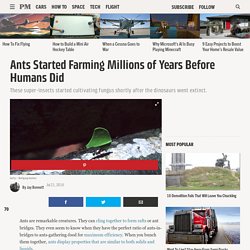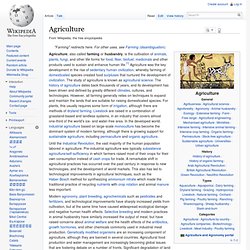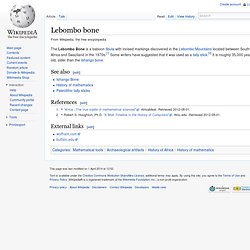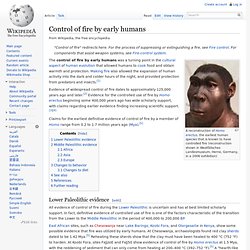

Ants Started Farming Millions of Years Before Humans Did. Ants are remarkable creatures.

They can cling together to form rafts or ant bridges. They even seem to know when they have the perfect ratio of ants-in-bridges to ants-gathering-food for maximum efficiency. When you bunch them together, ants display properties that are similar to both solids and liquids. And now we know that they were the world's first farmers.
Or, at least, they were farming long before humans were. Advertisement - Continue Reading Below. Imagination and reality flow in opposite directions in your brain. The below article first appeared in The Conversation on 1 August 2014.

That starling at your birdfeeder? It is a dinosaur. The chicken on your dinner plate? Also a dinosaur. That mangy seagull scavenging for chips on the beach? It may seem inconceivable, but birds are living dinosaurs. So although we often talk about the dinosaurs being extinct, there really are more than 10,000 species of living, breathing, bona fide dinosaurs. It is a wacky idea to get your head around. As somebody who studies dinosaurs for a living and teaches undergraduates about evolution and the history of life, I would say it is the single most important fact ever discovered by dinosaur palaeontologists.
When you look at a Tyrannosaurus rex and a chicken side-by-side, you can see the similarities. Agriculture. Agriculture, also called farming or husbandry, is the cultivation of animals, plants, fungi, and other life forms for food, fiber, biofuel, medicinals and other products used to sustain and enhance human life.[1] Agriculture was the key development in the rise of sedentary human civilization, whereby farming of domesticated species created food surpluses that nurtured the development of civilization.

The study of agriculture is known as agricultural science. Mathematics. Mathematics (from Greek μάθημα máthēma, “knowledge, study, learning”) is the study of topics such as quantity (numbers),[2] structure,[3] space,[2] and change.[4][5][6] There is a range of views among mathematicians and philosophers as to the exact scope and definition of mathematics.[7][8] Rigorous arguments first appeared in Greek mathematics, most notably in Euclid's Elements.

Since the pioneering work of Giuseppe Peano (1858–1932), David Hilbert (1862–1943), and others on axiomatic systems in the late 19th century, it has become customary to view mathematical research as establishing truth by rigorous deduction from appropriately chosen axioms and definitions. Mathematics developed at a relatively slow pace until the Renaissance, when mathematical innovations interacting with new scientific discoveries led to a rapid increase in the rate of mathematical discovery that has continued to the present day.[11] History Evolution Etymology. Cave of El Castillo. Access to the cave, in April 2008.

Engraved and perforated baton of the upper magdalenian found in the Cave of El Castillo. The Cueva de El Castillo, or the Cave of the Castle, is an archaeological site within the complex of the Caves of Monte Castillo, and is located in Puente Viesgo, in the province of Cantabria, Spain. It contains the oldest known cave art in the world. Hand stencils and disks made by blowing paint onto the wall in El Castillo cave were found to date back to at least 40,800 years, making them the oldest known cave art in Europe, 5-10,000 years older than previous examples from France. [1][2] As traditional methods such as radiocarbon dating do not work where there is no organic pigment, a team of UK, Spanish and Portuguese researchers led by Dr. Chauvet Cave. Drawings of horses from Chauvet Cave. Cave painting. Cave paintings are paintings found on cave walls and ceilings, and especially refer to those of prehistoric origin.

The earliest such art in Europe dates back to the Aurignacian period, approximately 40,000 years ago, and is found in the El Castillo cave in Cantabria, Spain. The exact purpose of the paleolithic cave paintings is not known. Evidence suggests that they were not merely decorations of living areas since the caves in which they have been found do not have signs of ongoing habitation. They are also often located in areas of caves that are not easily accessible. Some theories hold that cave paintings may have been a way of communicating with others, while other theories ascribe a religious or ceremonial purpose to them.
Lebombo bone. The Lebombo Bone is a baboon fibula with incised markings discovered in the Lebombo Mountains located between South Africa and Swaziland in the 1970s.[1] Some writers have suggested that it was used as a tally stick.[2] It is roughly 35,000 years old, older than the Ishango bone.

See also[edit] References[edit] External links[edit] Agriculture. Control of fire by early humans. A reconstruction of Homo erectus, the earliest human species that is known to have controlled fire (reconstruction shown in Westfälisches Landesmuseum, Herne, Germany, in a 2006 exhibition) The control of fire by early humans was a turning point in the cultural aspect of human evolution that allowed humans to cook food and obtain warmth and protection.

Making fire also allowed the expansion of human activity into the dark and colder hours of the night, and provided protection from predators and insects.[1] Evidence of widespread control of fire dates to approximately 125,000 years ago and later.[2] Evidence for the controlled use of fire by Homo erectus beginning some 400,000 years ago has wide scholarly support, with claims regarding earlier evidence finding increasing scientific support.[3][4] Lower Paleolithic evidence[edit] All evidence of control of fire during the Lower Paleolithic is uncertain and has at best limited scholarly support. Middle Paleolithic evidence[edit] Africa[edit] File:Humanevolutionchart.png.